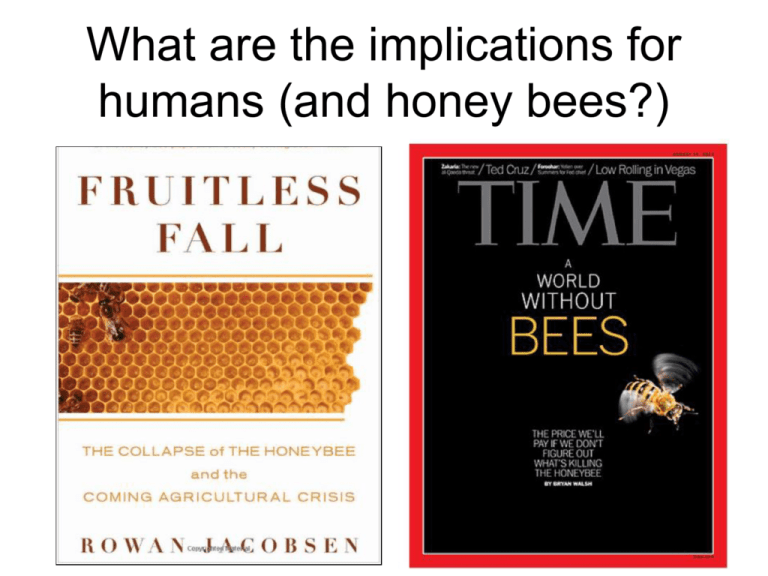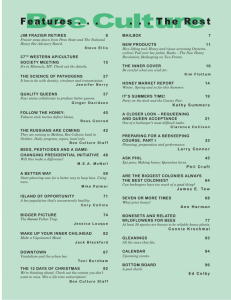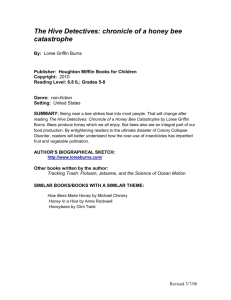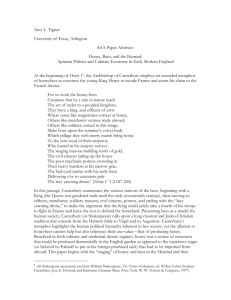CCD2
advertisement

What are the implications for humans (and honey bees?) “If the bee disappears from the surface of the earth, man would have no more than four years to live. No more bees, no more pollination... no more men!” No more humans? • Change in diet, but not human extinction • Major food crops (wheat, rice, and corn) wind pollinated • Third of food crops bee pollinated, but only some of these are highly dependent upon honey bees (for example, almonds) Rethinking the discourses about CCD and bee decline • They have often employed a greedy reductionist strategy – fixation on isolating a single cause often accompanied by exaggerated claims of the negative consequences of not doing so. Pests identified as cause of CCD The pest explanation: viral pathogen interacting with a fungal organism and varroa mite causes CCD Chemicals identified as cause of CCD Rethinking the narratives about CCD and bee decline • Both pests and pesticides contribute to CCD. Isolating a single cause oversimplifies many other factors and issues. There is the need to address the problems neonicotinoids and pests, but one should also look at more foundational causes. • “Dying bees have become symbols of environmental sin. By engaging in simplistic and sometimes misleading environmental narratives, by exaggerating the stakes and brushing over the inconvenient facts that stand in the way of foregone conclusions, we do a disservice” (Nordhaus, 2010) “If the bee disappears from the surface of the earth, man would have no more than four years to live. No more bees, no more pollination... no more men!” Less simplistic narratives about CCD and bee decline • Declines in honey bees in U.S. since World War 2 • Rise of global middle class and demand for luxury crops • Impacts of honey bee decline on human health will depend upon level of ‘hidden’ hunger • High prices for honey bee pollination services creates lock-in of conditions that cause die offs • Evidence of other bee declines in the past • Other factors than CCD more relevant for day-today work of beekeepers More bee-dependent luxury crops underlie shortage of bees Honey bee shortage driven by 300% increase (since 1950’s) in the amount of bee-dependent “luxury” crops Demand for luxury crops driven by affluence of new global middle class • Increased disposable income • Globalization brings greater diversity of imported specialty crops • Healthy eating prioritized over meeting basic caloric needs • High antioxidant, vitamin rich and often beedependent foods desired http://www.almonds.com • Result is a lack of honey bees to meet demand Long term decline of honey bees in U.S. • Five million honey bees at the end of World War 2 • Honey production outsourced to countries that can make it more cheaply • Fewer beekeepers domestically, although there are issues arising from honey imports Honey can be produced more cheaply in China and India. North American bee keepers stopped producing honey when honey imports began. The figure above shows US imports rising since the 1960’s International honey trade • Lower price undercuts American honey producers • Quality control an issue • Perpetuates many of the conditions that may be part of bee decline International honey laundering Nutrition is an ecosystem service of honey bees Fewer bees could impact availability of some vitamin-rich plant foods • 50% of plant sources of vitamin A require bee pollination • Disruptions in pollination have public health implications in some regions • Annually vitamin A deficiency causes 800,000 deaths in women and children. • Doubles risk of mortality from common conditions like measles, diarrhea, and malaria, increases the risk of maternal mortality Hidden hunger – imbalanced availability of macronutrients (fats, protein, and/or carbohydrates) and essential micronutrients (vitamins and minerals). Can cause nutrient-deficiency conditions as well as weaken the immune system, stunt development, and increase mortality from other diseases. Hidden hunger Although calcium and iron are absorbed more efficiently from meat and dairy sources, those foods are not available to all people due to high cost.




